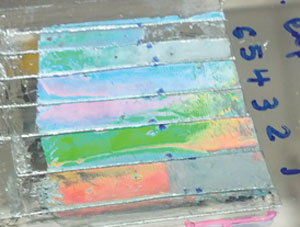Food Packaging
Smart labels aim to enhance food safety

|
| Researchers are developing materials that can be inserted into individual food packages, so they travel the supply chain with the products they are being used to monitor. Above are smart indicators immersed in different solutions, with some changing color. Source: University of Alberta. |
The project combines materials engineering, biological engineering and food microbiology. “We have taken materials and techniques from each of these disciplines and put them together to make a new material that is programmed to sense pathogens and undergo a response such as a change in appearance,” Elias says.
The project involves developing and combining three technologies: the stimulus-responsive polymer that makes up the smart material, the biological detection system and food microbiology. The research team has been programming the material to change color in the presence of disease-causing bacteria such as E. coli, Salmonella or Listeria, as well as in response to temperature changes. The material responds by changing appearance, for example, from colored to white or from clear to cloudy. With the smart materials, food suppliers and even consumers will instantly be able to see if a product has been contaminated just by looking at the color of the packaging.
Labels that detect temperature change are already available in Europe, but temperature is only an indirect indicator of food spoilage. The key difference with these smart materials is that they indicate the presence of pathogens and help show exactly where contamination occurred in the supply chain.
The smart materials will be incorporated into food packaging to help improve safety at every stage of food processing, from the packaging facility to consumers’ refrigerators. “We are developing materials that can be inserted into individual food packages, so they travel the supply chain with the products they are being used to monitor,” Elias says.
Where in the package the smart label is placed will ultimately be decided based on industry and consumer input. Because the material must come into direct contact with the food, layering it in the packaging is a good option. “The larger the sensor fabricated from the smart materials is, the greater the likelihood it will come into contact with pathogens. However, visual inspection of the product is important to consumers, so we have to ensure the meat can be seen,” says Elias.
It will be a few more years before the smart labels reach the commercial market. The next steps are exploring the limits of the sensitivity of these materials, testing to ensure false positives do not occur, working with regulators to verify the materials can come into contact food safely and scaling up production.
For more information: Anastasia Elias, 780-248-1589, aelias@ualberta.ca
Looking for a reprint of this article?
From high-res PDFs to custom plaques, order your copy today!




-FDA_Logo-(2).webp?height=200&t=1710227168&width=200)


